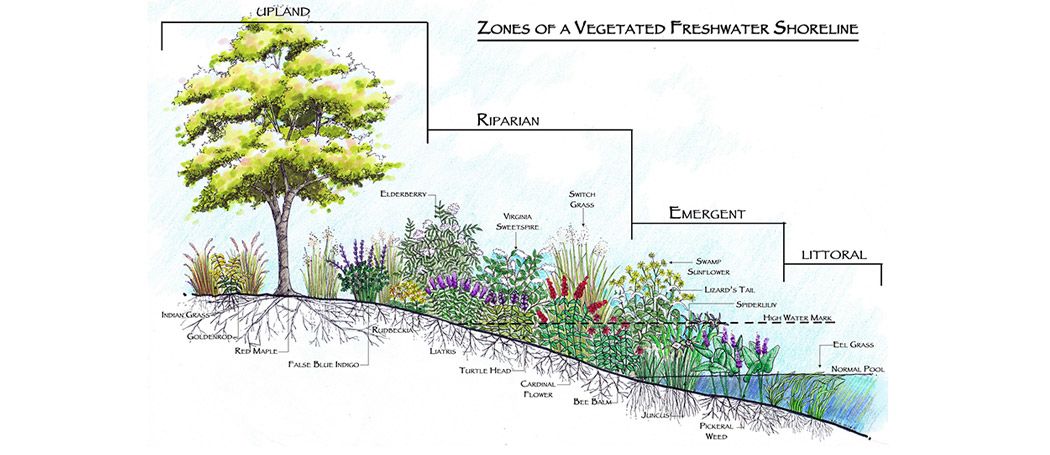Plants and Your Stormwater Control Measures
Vegetation establishment is an important component of many stormwater control measures (SCM). Grasses, trees, shrubs, and other herbaceous plants help provide structural stability, conrol erosion, and naturally remove pollutants from rainwater runoff. However, if proper maintenance is not performed, undesirable vegetation will invade vegetated areas of the SCMs. If these undesirables go untreated, they can inhibit the function of the stormwater control to convey, treat, and/or store water from storm events. Furthermore, some desirable plants can become undesirable if they establish in unwanted areas. For instance, turf grasses invading a planted/mulched area or trees establishing on the floor of a dry detention basin.
Desirable vegetation needs periodic maintenance to ensure that it remains healthy and established. Desired plant communities can be detrimentally compromised through climate changes, lack of proper maintenance, infrequent storm events, vehicular/equipment traffic, and vandalism. In these instances, supplemental and replacement planting may be needed for effected areas. This should occur during the appropriate planting season for the particular plant species being used and need additional care until they are established.
Grasses and Herbaceous Plants
The plants listed in the following sections reflect communities in the Southeast.
Turf-type grasses provide soil stability, reduce flow velocity, and maintain the structural integrity of SCMs.
- Centipedegrass
- Bermudagrass
- Zoysia
- Tall Fescue
- Bahiagrass
- Kentucky Bluegrass
Provisions should be made to reestablish a uniform cover of turf grass on areas damaged by sediment accumulation, stormwater flow, and/or other disturbances. Failure to maintain could result in structural failure.
Many times herbaceous plants and native/ornamental grasses are used to help the stuructural integrity of the SCM as well as remove nutrients and other pollutants from stormwater runoff.
Herbaceous Plants
- Smooth Aster
- Purple Cone Flower
- Joe Pye Weed
- Swamp Sunflower
- Ox Eye Sunflower
- Marsh Mallow
- Blug Flag Iris
- Cardinal Flower
- Wild Bergamot
- Sweeet Coneflower
- Showy Goldernrod
- Virginia Spiderwort
- New York Ironweed
Hebaceous plant material should be allowed to die-back at the end of the season.
Native/Ornamental Grasses
- Big Bluestem
- Bushy Bluestem
- River Oats
- Soft Rush
- Pink Muhly Grass
- Switch Grass
- Wool Grass
- Indian Grass
- Smooth Cord Grass
- Cord Grass
Native/ornamental grasses should be cut back every 2-3 years depending on the plant’s growth during that period. Cut back should be delayed until the later winter months to allow the plants’ ornamental quality to show. Evergreen native grass such as Juncus should not be cut back as they provide pollution uptake while other plants are dormant.
Trees and Shrubs
Trees and shrubs are often used with SCMs to provide shade and help control water temperatures. High water temperatures and direct sunlight can cause an increase in algal blooms. Trees surrounding SCMs also help provide a safety barrier for people and blend the SCM into the landscape.
Schrubs
- Red Chokeberry
- Beautyberry
- Buttonbush
- Summersweet
- Redosier Dogwood
- Inkberry
- Yaupon Holly
- Winterberry
- Virginia Sweetspire
- Wax Myrtle
- American Elderberry
Trees
- Downy Serviceberry
- Flowering Dogwood
- American Holly
- Eastern Red Cedar
- Sweetbay Magnolia
- Black Gum
- Overcup Oak
- Chestnut Oak
- Nuttall Oak
- Bald Cypress
Tree and Shrubs should be maintained in a healthy condition. They should be monitored forr disease or insect infestation problems and treated accordingly.
If maintenance is not performed properly, undesirable vegetation will dominate the vegetated areas of the SCM. These plants are aggressive in nature and have seeding habits that are unwanted where species diversity in desired.
Undesirable Plants
Weeds
- Common Ragweed
- Hairy Bittercress
- Chickweed
- Spotted Spurge
- Labsquarter
- Horseweed
- Virginia Buttonweed
- Carolina Geranium
- Ground Ivy
- Morning Glory
- Prickly Lettuce
- Henbit
- Common Lespedeza
- Carpetweed
- Plantain
- Prostrate Knotweed
- Pink Purslane
- Blackberry
- Red Sorrel
- Curly Dock
- Florida Betony
- Hop Clover
- Vetch
Grasses
- Common Bermudagrass
- Yellow Nutsedge
- Purple Nutsedge
- Japanese Stiltgrass
- Cattail
Trees
- Red Maple
- Tree of Heaven
- Sweetgum
- Princess Tree
- Black Willow
Remove undesirable vegetation before it is established. Once established, these plants can have an adverse effect on the survivability of desirable plants and the aesthetic appeal of the SCM. The best time to do this is during routine maintenance activities. Undesirable plants can be removed by physical, mechanical, and/or herbicidal practices. Dispose of the trimmed plant material properly; do not discard into waterways because the material could clog the waterways and add nutrients to the water.
Reference
NCDOT SC Inspection and Maintenance Manual (NCDOT-HS-2010-01)
 Kenosha, Wis. Highway KR Regenerative Stormwater ConveyanceThe Root-Pike Watershed Initiative Network Kenosha County, and others worked with AQUALIS to design and implement an innovative solution for stormwater control along Highway KR.
Kenosha, Wis. Highway KR Regenerative Stormwater ConveyanceThe Root-Pike Watershed Initiative Network Kenosha County, and others worked with AQUALIS to design and implement an innovative solution for stormwater control along Highway KR. Durham, N.C. Sinkhole Leads to Stormwater System RehabilitationThe tenant on this property noticed a depression that opened to the ground below and notified the property owners.
Durham, N.C. Sinkhole Leads to Stormwater System RehabilitationThe tenant on this property noticed a depression that opened to the ground below and notified the property owners.

